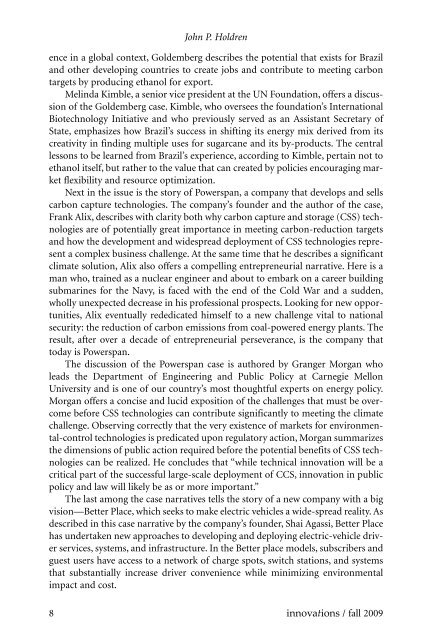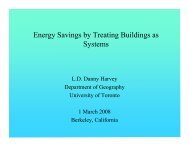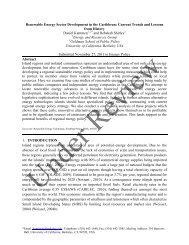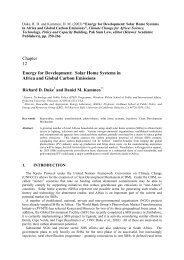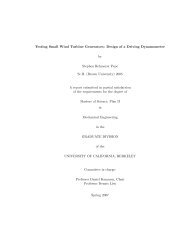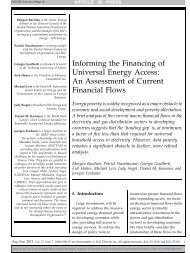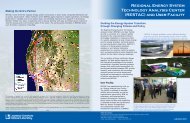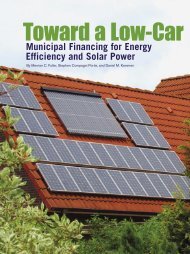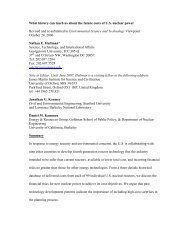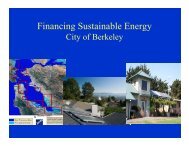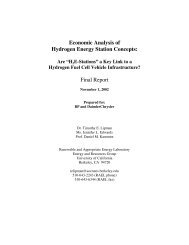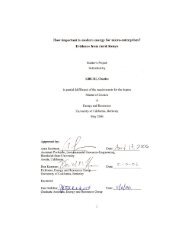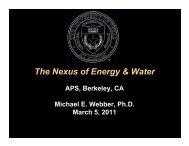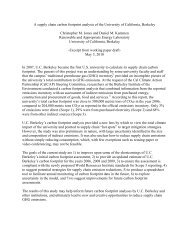Innovations, Energy for Change, Fall 2009.pdf - Renewable and ...
Innovations, Energy for Change, Fall 2009.pdf - Renewable and ...
Innovations, Energy for Change, Fall 2009.pdf - Renewable and ...
You also want an ePaper? Increase the reach of your titles
YUMPU automatically turns print PDFs into web optimized ePapers that Google loves.
John P. Holdren<br />
ence in a global context, Goldemberg describes the potential that exists <strong>for</strong> Brazil<br />
<strong>and</strong> other developing countries to create jobs <strong>and</strong> contribute to meeting carbon<br />
targets by producing ethanol <strong>for</strong> export.<br />
Melinda Kimble, a senior vice president at the UN Foundation, offers a discussion<br />
of the Goldemberg case. Kimble, who oversees the foundation’s International<br />
Biotechnology Initiative <strong>and</strong> who previously served as an Assistant Secretary of<br />
State, emphasizes how Brazil’s success in shifting its energy mix derived from its<br />
creativity in finding multiple uses <strong>for</strong> sugarcane <strong>and</strong> its by-products. The central<br />
lessons to be learned from Brazil’s experience, according to Kimble, pertain not to<br />
ethanol itself, but rather to the value that can created by policies encouraging market<br />
flexibility <strong>and</strong> resource optimization.<br />
Next in the issue is the story of Powerspan, a company that develops <strong>and</strong> sells<br />
carbon capture technologies. The company’s founder <strong>and</strong> the author of the case,<br />
Frank Alix, describes with clarity both why carbon capture <strong>and</strong> storage (CSS) technologies<br />
are of potentially great importance in meeting carbon-reduction targets<br />
<strong>and</strong> how the development <strong>and</strong> widespread deployment of CSS technologies represent<br />
a complex business challenge. At the same time that he describes a significant<br />
climate solution, Alix also offers a compelling entrepreneurial narrative. Here is a<br />
man who, trained as a nuclear engineer <strong>and</strong> about to embark on a career building<br />
submarines <strong>for</strong> the Navy, is faced with the end of the Cold War <strong>and</strong> a sudden,<br />
wholly unexpected decrease in his professional prospects. Looking <strong>for</strong> new opportunities,<br />
Alix eventually rededicated himself to a new challenge vital to national<br />
security: the reduction of carbon emissions from coal-powered energy plants. The<br />
result, after over a decade of entrepreneurial perseverance, is the company that<br />
today is Powerspan.<br />
The discussion of the Powerspan case is authored by Granger Morgan who<br />
leads the Department of Engineering <strong>and</strong> Public Policy at Carnegie Mellon<br />
University <strong>and</strong> is one of our country’s most thoughtful experts on energy policy.<br />
Morgan offers a concise <strong>and</strong> lucid exposition of the challenges that must be overcome<br />
be<strong>for</strong>e CSS technologies can contribute significantly to meeting the climate<br />
challenge. Observing correctly that the very existence of markets <strong>for</strong> environmental-control<br />
technologies is predicated upon regulatory action, Morgan summarizes<br />
the dimensions of public action required be<strong>for</strong>e the potential benefits of CSS technologies<br />
can be realized. He concludes that “while technical innovation will be a<br />
critical part of the successful large-scale deployment of CCS, innovation in public<br />
policy <strong>and</strong> law will likely be as or more important.”<br />
The last among the case narratives tells the story of a new company with a big<br />
vision—Better Place, which seeks to make electric vehicles a wide-spread reality. As<br />
described in this case narrative by the company’s founder, Shai Agassi, Better Place<br />
has undertaken new approaches to developing <strong>and</strong> deploying electric-vehicle driver<br />
services, systems, <strong>and</strong> infrastructure. In the Better place models, subscribers <strong>and</strong><br />
guest users have access to a network of charge spots, switch stations, <strong>and</strong> systems<br />
that substantially increase driver convenience while minimizing environmental<br />
impact <strong>and</strong> cost.<br />
8 innovations / fall 2009


